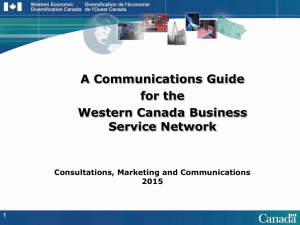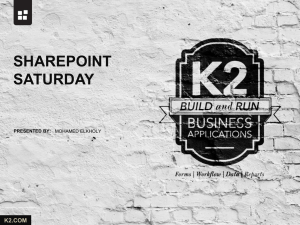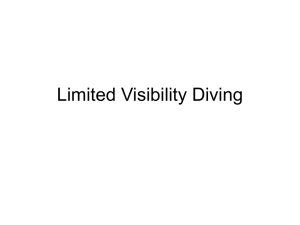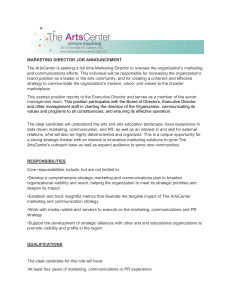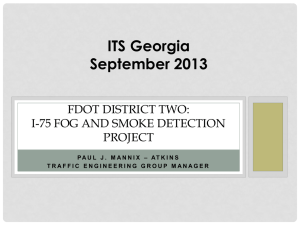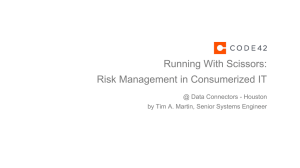A common right to allow IP authors to control error handling is
advertisement
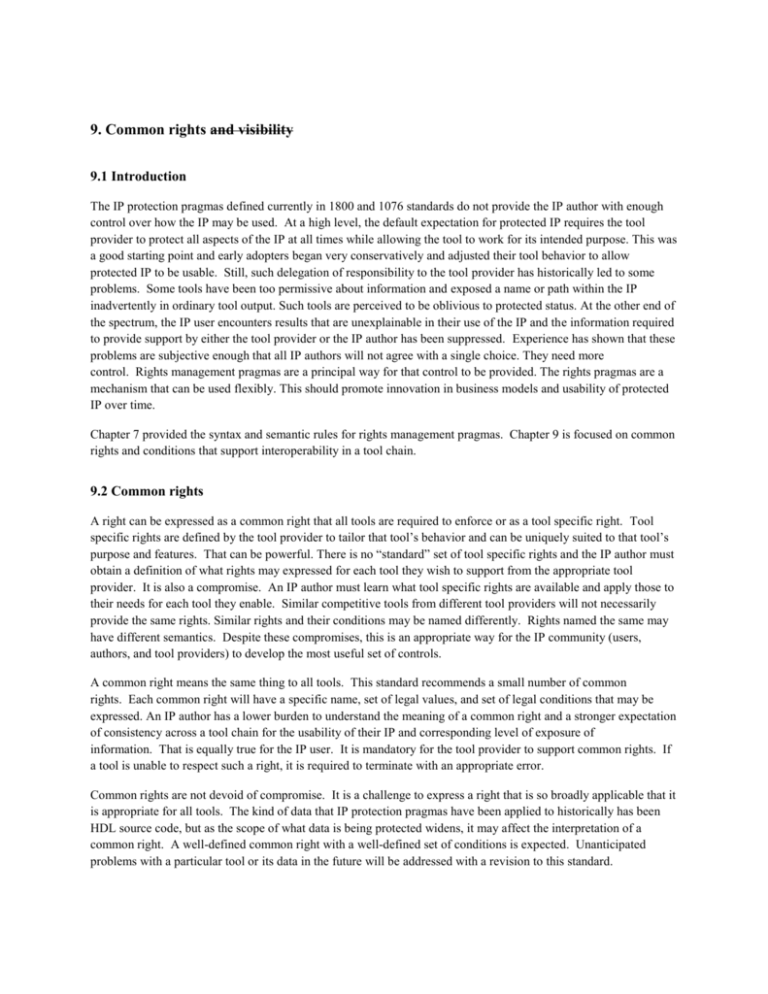
9. Common rights and visibility 9.1 Introduction The IP protection pragmas defined currently in 1800 and 1076 standards do not provide the IP author with enough control over how the IP may be used. At a high level, the default expectation for protected IP requires the tool provider to protect all aspects of the IP at all times while allowing the tool to work for its intended purpose. This was a good starting point and early adopters began very conservatively and adjusted their tool behavior to allow protected IP to be usable. Still, such delegation of responsibility to the tool provider has historically led to some problems. Some tools have been too permissive about information and exposed a name or path within the IP inadvertently in ordinary tool output. Such tools are perceived to be oblivious to protected status. At the other end of the spectrum, the IP user encounters results that are unexplainable in their use of the IP and the information required to provide support by either the tool provider or the IP author has been suppressed. Experience has shown that these problems are subjective enough that all IP authors will not agree with a single choice. They need more control. Rights management pragmas are a principal way for that control to be provided. The rights pragmas are a mechanism that can be used flexibly. This should promote innovation in business models and usability of protected IP over time. Chapter 7 provided the syntax and semantic rules for rights management pragmas. Chapter 9 is focused on common rights and conditions that support interoperability in a tool chain. 9.2 Common rights A right can be expressed as a common right that all tools are required to enforce or as a tool specific right. Tool specific rights are defined by the tool provider to tailor that tool’s behavior and can be uniquely suited to that tool’s purpose and features. That can be powerful. There is no “standard” set of tool specific rights and the IP author must obtain a definition of what rights may expressed for each tool they wish to support from the appropriate tool provider. It is also a compromise. An IP author must learn what tool specific rights are available and apply those to their needs for each tool they enable. Similar competitive tools from different tool providers will not necessarily provide the same rights. Similar rights and their conditions may be named differently. Rights named the same may have different semantics. Despite these compromises, this is an appropriate way for the IP community (users, authors, and tool providers) to develop the most useful set of controls. A common right means the same thing to all tools. This standard recommends a small number of common rights. Each common right will have a specific name, set of legal values, and set of legal conditions that may be expressed. An IP author has a lower burden to understand the meaning of a common right and a stronger expectation of consistency across a tool chain for the usability of their IP and corresponding level of exposure of information. That is equally true for the IP user. It is mandatory for the tool provider to support common rights. If a tool is unable to respect such a right, it is required to terminate with an appropriate error. Common rights are not devoid of compromise. It is a challenge to express a right that is so broadly applicable that it is appropriate for all tools. The kind of data that IP protection pragmas have been applied to historically has been HDL source code, but as the scope of what data is being protected widens, it may affect the interpretation of a common right. A well-defined common right with a well-defined set of conditions is expected. Unanticipated problems with a particular tool or its data in the future will be addressed with a revision to this standard. 9.2.1 Default value Every common right shall have a default value. If that right has not been defined in a common rights block, it will be presumed to have this value and apply to all tools unless overridden (see 9.3). 9.2.2 The delegated value The default expectation for protected IP requires the tool provider to protect all aspects of the IP at all times while allowing the tool to work for its intended purpose. This, in effect, delegates the responsibility to the tool provider to interpret this default expectation. It is possible that similar tools will not have an identical interpretation. Every common right should have a value, named delegated , that means accept the default expectation. A useful implication of the rules for common and tool specific rights and the use of the delegated value is that it will always be possible to express a common right in a tool specific rights block to eliminate its applicability. At the same time, it is very transparent decision to all stakeholders. 9.3 Overriding common rights As defined in 7.5.4, an IP author can override a specific common right in a tool specific rights block. The meaning of a common right expressed in a tool specific rights block cannot be arbitrarily changed by the tool provider. Its value can be overridden by another legal value for that right. If that mechanism and the tool specific rights available for that tool are not acceptable to the IP author, the only other recourse is to not allow that tool to work with their IP until it meets expectations. 9.4 Common conditions for rights A common condition is a definition of a keyword and legal values that conforms to the rules of 7.5.3. A common condition may be applied to common or tool specific rights, but does not automatically apply to any right. A proper definition of a right must include the specification of all valid conditions that may be used to qualify it. Common conditions support consistency across common and tool specific rights for common concepts. The definition of a common condition may not be redefined by a tool provider for use in a tool specific rights block. If there is a perceived need, the tool provider must use a different name for the condition. On the other hand, a tool provider may extend the legal values for a common condition for use within their supported tool specific right. 9.4.1 Tool Phase Condition Tool phase partitions the execution of a tool into a common set of abstract phases. It provides control for IP authors to limit the applicability of certain rights. It is expressed as: tool-phase = compile | elaborate | run Where: Compile – is the abstract phase where the IP is read into the tool and checked in any manner for selfconsistency and correct semantics for its representation. It is generally independent of the IP user’s actual use of the protected IP. Elaborate – is the abstract phase where the IP user’s design is being constructed into some information model for use by the tool and where protected IP is being referenced for that purpose. Run – is the abstract phase where the tool is functioning for its intended purpose and during which it may generate outputs that could contain references to information contained within protected IP 9.4.2 Activity Condition The activity condition classifies a tool. It is useful to factor the broad range of tools useful in design flows into a small common set of abstract activities in order to qualify a right. The tool provider must make it clear to the IP author which activity values apply to their tool. The activity condition is expressed as: activity = simulation | synthesis | analysis | layout Where: simulation – the abstract activity that applies to tools that provide execution semantics synthesis – the abstract activity that applies to tools that transform the IP into another symbolic form analysis – the abstract activity that applies to tools which evaluate the IP without execution semantics and reports on properties derived from the IP specification layout – the abstract activity that applies to tools which transform the IP into rendering instructions for physical fabrication It is possible to classify tools in many ways, of course. This current classification is broad enough to apply almost all the tools in a tool chain where IP protection applies. 9.4.3 License Condition A license condition as described in Chapter 8 provides a mechanism for granting a right to a specific IP user by the IP author. It is important for the expression of both common rights and tool-specific rights. The common license condition accepts a string describing the license feature and returns the value true or false. Note, the external license concept in which a tool specific value is returned is, by its definition, an invalid use case for a common right. 9.5 Common right for error handling 9.5.1 Background All tools do error checking and report errors and warnings to the user. The quality of those error messages reflects on the usability of those tools, and by extension, the quality of protected IP. With respect to protected IP, the information that is hidden may make the difference between a useful and a useless error message. It is impossbile to predict all the ways in which protected IP may be reused and expose an unexpected flaw. An IP user composes a design using protected IP and, in the process, an error occurs. The root cause of that error may be in the user’s design, in the IP itself, in the use of the IP in an unanticipated manner, or in the implementation of the tool being used. Regardless of the root cause, the first manifestation of the error may be in the context of the protected IP. What are the reasons IP authors choose to protect information from being made transparent in error messages? The fundamental concern with protection is that IP is valuable. If the original and complete design can be stolen and reused freely, it will damage the business of the IP author. If tool outputs were free to report anything, IP users might reconstruct the IP from them. Where do error messages fit? Tool outputs are generally user directed, but error messages are fundamentally not. They are responses to real or possible problems. It is highly unlikely for IP of more than trivial complexity that information in error messages will fundamentally compromise the IP and allow essential information to be stolen. There is a good argument that protected IP will be more usable with error messages that are transparent and the risk of loss of value will be little to none. Nevertheless, it may be possible to learn something about the structure of IP by the pathname to an internal object and the names given to the path elements and the object itself. One aspect may just be the identity of an internal supplier whose IP is being reused in the composition of the protected IP. Not all IP authors will be willing to provide transparent error messages. Another alternative that can substitute for transparent names is a reference to the object only understood by the IP author. One such mechanism that is commonly available is a src code reference. The file and line number associated with the original source code of the IP, provided it is preserved in the tool, is a valid alternative. 9.5.2 Definition A common right to allow IP authors to control error handling is error-handling = delegated | nonames | srcrefs | plaintext, where: delegated - tool complies with the default expectation and may report some information with certain errors in order to allow the tool to be usable for its intended purpose. nonames – absolutely no information that refers to a name in a protected region of the IP may be reported in any error or warning. That is the most paranoid and draconian setting for this right and effectively absolves the tool provider of providing support for interpreting the error for the IP user and places that burden on the IP author. srcrefs – where it is possible for a tool to provide it, a source reference to an associated file and line number of unencrypted source is to be used wherever a name would otherwise appear. If it is not possible, treat names as if “error-handling = delegated”. srcrefs is a straightforward form of obfuscation. It may benefit from non-standard line control directives in the original source code, depending on tool behavior. plaintext – any references to internal names in error messages are presented as plain text in the same manner as if they did not originate from an encryption envelope The common conditions which may be applied to error-handling are tool-phase, activity, and license. 9.5.3 Obfuscation Allowing error handling with srcrefs is one example of a basic technique to hide information in plain sight -obfuscation. The original source code of the IP can be pre-processed to obscure internal names and code structure. If an IP author takes steps to obfuscate before encrypting their IP, being transparent in error messages will produce output that they can interpret, but which the IP user or tool provider cannot. For some, this will make the difference for allowing plaintext messages. IP authors should consider this technique as independent and complementary to IP protection. 9.6 Common right for visibility There are multiple mechanisms to control visibility. A complete discussion appears in Chapter 10. The most expressive mechanism is a common right that applies to the entire IP without requiring identification of specific names. This section defines this right and how it is useful. 9.6.1 Use cases There is a separation between interface and implementation in IP descriptions. For an IP user, the interface must be open and documented in order to reference the IP in a design. One cannot instantiate a SV module or VHDL entity without such information. An IP user cannot write formal assertions for the interface without it either. The implementation is internal and normally, no aspect of it is needed for reasonable use of an IP. It is common for an IP author to allow the visibility of interfaces for an IP user while keeping implementation protected. There is a use case in which all names within protected IP, interface and implementation are visible. Note, this does not mean that the entire source of the IP is visible and unprotected. Not all IP that gets protected involves a 3 rd party supply chain. An IP user and IP author may in fact be members of the same organization, but with different roles. The IP user may be a verification engineer and the IP author, the design engineer. What IP protection with this kind of visibility enforces is the discipline that no design change and no white box testing of the IP is granted to the verification engineer, but complete introspection of data and access to internal controls is. This kind of access allows for design assertions to be written that reach beyond the interface and all internal coverage details to be exposed. 9.6.2 Definition A common right to allow IP authors to grant runtime visibility within protected IP is: runtime_visibility = delegated | interface_names | all_names The common conditions which may be applied to runtime_visiblity are activity and license. While it might seem reasonable that tool-phase should apply, Chapter 10 discusses the considerations for visibility and tool-phase that rule out use of the tool-phase condition. 9.7 Common right for decryption Protecting IP for a set of tools using the digital envelope use model grants some use of that IP to any user by proxy. It is the tool that is the proxy. In order to limit the ability to have any right to use a protected IP for a particular user, licensing must be used. Requiring a successful license check before allowing any processing and decryption of protected IP improves security at the cost of providing a license service for the IP author. 9.7.1 Definition A common right to allow IP authors to control error handling is decryption = delegated | true | false, where: true – means the IP can be decrypted as part of tool processing false – means the IP cannot be decrypted and will cause a fatal tool error. delegated – is the default value and equivalent to true. The common condition which may be applied to decryption is license. Indeed, the use of this right only makes sense in conjunction with a license condition. For example: `protect control decryption = license("basic") ? "true" : “false” 9.7.2 Deprecated IP protection pragma The decrypt_license pragma defined in IEEE 1800 and 1076 LRMs is superceded by licensing as a condition in a right. The decrypt_license pragma is not interoperable and is inherently very weak as a protection mechanism. It is recommended to be removed from those LRMs. 10.0 Visibility management 10.1 Introduction The ability to control what is visible and when it is visible in a protected IP is a basic capability that IP authors need. The 1076 and 1800 LRMs currently do not adequately define the semantics of protection. The existing mechanisms and their limitations are described first, to clarify those semantics. In addition, new mechanisms are defined that provide flexibility for IP authors to make their IP more or less usable within tools, where visibility of information is the concern. 10.2 Background The default expectation for protected IP requires the tool provider to protect all aspects of the IP at all times while allowing the tool to work for its intended purpose. This responsibility is delegated to the tool provider by the IP author when a tool is allowed to work with a protected IP. With respect to visibility, this has meant no names inside the IP are visible, hierarchical paths into or through protected IP are opaque, tool and design data inputs from the IP user cannot refer to names inside the IP, tool outputs including errors and warnings make no references to names or anything recognizable to the tool vendor or the IP author. In other words, this has been interpreted in a conservative manner and in some cases, draconian. However, when the tool has been proven to be unusable for its intended purpose without certain visibility, it has been corrected. There are 2 areas where that has been proven to be valid. 10.2.1 Model fidelity Visibility is required in some cases to insure that the model behaves in the same manner when protected as it did in its unprotected state. It is a fundamental expectation that IP protection is a lossless transformation. This occurs when a model is written to produce output that is introspective and by its nature reveals information. This is true for HDL models where the language supports a mechanism and the IP author chose to use that mechanism. Here are a couple of examples: %p is $display in SV `path_name,`instance_name in VHDL The default expectation described above applies to tool behavior, not model behavior. It is invalid for a tool to modify the behavior of the model that the IP author wrote. The IP author requires no further mechanism to control visibility in these cases than what is already available in the language. 10.2.2 Tool Phases Some visibility is required in tool phases to meet the default expectation. This section motivates the need for additional controls as well as provides an understanding of inherent limitations. Tool phases have already been defined as a common condition in 9.4.1. 10.2.2.1 Compile Visibility Compile is the abstract phase that refers to analysis of protected IP definitions. Conceptually, those definitions are independent of any use of it by the IP user. During compile, IP may make self-references that must be inherently visible. IP users are expected to reference information in protected IP such as types and interfaces (parameters, ports, etc.) that also must be visible to support the compilation of their own code. While this implicit visibility is fundamental, there is no requirement for a tool to make anything explicitly visible in its tool outputs during compile. The IP user’s understanding of names and their purpose within the IP is provided independently by the IP author through documentation. There is also no restriction of this implicit visibility except that it remain internal to the tool. The IP author was expected to validate that their IP would compile before being protected. Surely it will compile for the IP user after protection without the need to expose anything to the IP user, right? There are a few general ways in which compilation may fail: The IP user may be allowed to define macros which are referenced within the IP and cause an error The language used to describe the IP (SV, VHDL ) changes or tightens semantic restrictions after the IP has been protected. There are numerous examples in the history of SV. A newer tool version has an unfortunate bug Some of these failures experienced by the IP user can be handled by the IP author without increasing visibility of the protected IP in tool outputs. However, If the IP author cannot use the identical tool version or cannot get access to the IP user’s code, it can be very difficult resolve some of these problems without increasing visibility. Regardless, without increasing visibility, the support may be expensive and involve the collaboration of all stakeholders. 10.2.2.2 Elaborate Visibility Elaborate is the abstract phase where the IP user’s design is being constructed into some information model for use by tool and where protected IP is being referenced for that purpose. These references in HDL source code include support for instantiation, hierarchical references, binding of assertions, etc.. Many references are finalized at this time and the failure to resolve a reference can be a fatal error. Parameter values are often finalized which may violate a constraint or expose an inconsistency. Like the compile phase, these references may be self-references within the protected IP or originate from user code. This leads to same requirements for implicit visibility of all names that are reference-able during elaboration without restriction, too. There is also no restriction of this inherent visibility except that it remains internal to the tool. The difference between the compile and elaborate phases and the visibility requirements is only in the details of what can be referenced and the nature of the composition errors that can be made by the IP user. The details are strictly specified by the syntax and semantics of the protected IP representation, i.e., the1800 and 1076 LRMs. The nature of elaborate errors is that the IP user is more likely to cause them than compile errors and they can be more difficult to resolve without access to both IP user and author source code or better visibility in tool outputs. 10.2.2.3 Run Visibility Run is the abstract phase where the tool is functioning for its intended purpose and during which it may generate outputs that could contain references to information contained within protected IP. In general, there are no requirements for implicit visibility other than model fidelity (10.2.1) and the default expectation to protect information must be honored. The same consideration for visibility within error messages applies to the run toolphase. 10.3 Existing visibility controls The primary control over visibility is the encryption envelope. An IP author may protect subsets of their IP, leaving the remainder unprotected. There is also a viewport pragma. Both have limitations. 10.3.1 Encryption envelopes Encryption envelopes define a protected region and are used to control visibility in a body of HDL code. The current definition in both SystemVerilog and VHDL is that protect pragmas that define these envelopes can be placed between any tokens in the language. As such, one can protect an arbitrary subset of any HDL description with granularity down to an individual token. Judiciously applied, it suggests any desired partition between fully visible and protected is possible and supportable by using some number of disjoint encryption envelopes. Unfortunately, the relationship between a protected subset and its surrounding HDL does not have an adequate semantic definition (see 10.5.1 and 10.5.2). 10.3.1.1 Limitations Using encryption envelopes to control visibility is costly. The IP author would prefer to complete their IP and encapsulate with protection without touching the validated source code. Mechanisms to control visibility that are rights based are ideal for this purpose. Using disjoint encryption envelopes requires the most intrusive change to the source code. In general, it is also not interoperable across a tool chain (see 10.5.1). 10.3.1.2 Recommendations Only design unit granularity should be used by IP authors. The potential for elaboration issues and structural overhead with declaration granularity should be sorted out in the language working groups first before finer granularity is recommended. Design unit granularity means only whole packages, package bodies, entities, architectures, and configurations in VHDL can be protected. In SystemVerilog, this means the equivalent granularity is packages, modules, programs, etc. This model fits a common use case for protecting entire libraries of components. It is compatible with encryption tools that support an encapsulation use model. In this scenario, an entire source file or set of source files are protected with protection pragmas defined externally. The result is equivalent to protecting each design unit individually with the same directives. 10.3.2 Viewport pragma The viewport pragma provides a detailed mechanism for visibility that involves explicit specification of objects by name and the nature of their visibility. 10.3.2.1 Background The current definitions in SystemVerilog and VHDL are inconsistent. The VHDL Viewport Directive is portable and rigorous. Object specification is tied to the formal information model defined by VHPI. The SV Viewport Directive is not in any way portable. Neither has any concept of execution phases, but appears to be focused only on runtime objects that have values. The viewport pragma must be improved or replaced. 10.3.2.2 Recommended improvements The viewport pragma shall only apply to the run tool phase. Its mechanism is focused on making a name visible and unprotected. The name may be referenced as a tool input and appear freely in tool outputs. While this addresses permission for a name to be visible, tool behavior may freely optimize that visibility away for other considerations such as performance. Mechanisms to guarantee visibility at runtime are tool specific concerns that have nothing to do with IP protection. Names that are reference able in a viewport pragma are with respect to design unit definitions. The pragma must appear in the source code prior to the declaration of the associated name within the design unit. A pathname may be used to refer to a name within the uninstantiated hierarchy of the IP. A viewport pragma is checked for correct syntax by the encryption tool, but no semantic checks are required at that time. At compile and/or elaborate tool phases, a semantic check must be performed to validate the existence of the name within the IP. A warning that shall be visible to the IP user that a name referenced in a viewport pragma cannot be found. The name in a viewport pragma cannot be a hierarchical pathname (absolute or relative) in the elaborated design of the IP user. There are few more details to work out here. The goal is allow at IP author to make specific aspects of the internal interface or implementation of an IP visible by name. Other mechanism can easily expose interface, but this is intended to allow a reach into an IP to access things that show or manipulate essential internal state It is not clear that any qualification of visibility serves IP protection. The semantics of language govern what access is meaningful and the IP author documentation provides the guidance about purpose for providing visibility. It is not whether access restrictions might useful, it is whether an IP protection mechanism is appropriate. Other means including assertions are much better at enforcing semantic rules and can help in the development and testing of the IP when it is unprotected. 10.3 Rights-based visibility controls Rights management provides a potentially rich mechanism for controlling visibility. It is described in Chapter 7. Common rights are defined to control visibility for error handling and common use cases that apply to the entire IP. This has been described in Chapter 9. Tool specific rights are very flexible. They are not standardized across common classes of tools. Negotiation between tool providers and IP authors and market forces will determine what private visibility controls become available. 10.4 Unresolved Issues If a name is made visible by an IP author by some mechanism, it implies the path to that name in the IP user’s use of that IP will be visible. Under what conditions should the path not be visible? It may not be possible, for technical reasons, to recognize those conditions, but we can point them out. 10.5 Future considerations Visibility is a complex area and some aspects are beyond the scope of this version of 1735. Some are specific to representation being encrypted and can only be addressed in the relevant standard, i.e., 1076 and 1800 currently. 10.5.1 Granularity of encryption envelopes As was stated in 10.3.1, the current definition in both SystemVerilog and VHDL is that protect pragmas that define these envelopes can be placed between any tokens in the language. The spirit was good, to be flexible and expect protection to be used in ways that aren't anticipated. However, this is a case where not having restrictions hurts interoperability. The relationship between a protected subset and its surrounding HDL does not have an adequate semantic definition. It is out of scope for this standard to define language specific rules for what is legal granularity. It is recommended that the 1800 and 1076 standards define: a granularity that is supportable rules for granularity which, when violated, cause a semantic error when semantic checking of granularity happens This standard does have suggestions to support that effort: granularity should be expressed in the formal information model for VPI and VHPI. That can be tied effectively to the syntax. Encryption envelopes enclosing finer granularity are then illegal, ignored, or considered to cover the entire protectable aspect of the model, as appropriate. protection of a subset of a single decl or stmt should not be allowed careful consideration of individual decls within container decls like SystemVerilog classes. Avoid using IP protection where other language mechanism meets the real requirements better for interoperability, a conservative definition of granularity based on known use cases is better It would be ideal if encryption tools were required to check granularity rules. That is directly contradicted in the HDL LRMs, where encryption tools are expected to ignore the HDL text. It also is conflict with encapsulation of any representation of IP with a common set of protection pragmas. It should required that decryption tools check these rules and it would be ideal if these checks were enforced as syntax errors so that they would be detected as early as possible. An IP author that doesn't validate their protected IP with the same tools an IP user will use before shipping deserves the bad reputation given them if granularity errors exist. 10.5.2 Relationship between disjoint protected envelopes The use of multiple protected envelopes and unprotected subset of source code to control visibility may have been necessary in the past. One consequence is that there are a set of disjoint protected envelopes in an IP. What constitutes a single logical IP is neither defined nor enforceable. That IP may have been protected in a single session of an encryption tool or multiple sessions. This use case is further complicated when an IP user employs multiple protected IPs from different IP authors. All of the protected envelopes from all sources have no relationship between each that can be used to define rights or enforce visibility rules. A fundamental consequence of this is the visibility requirements for the tool phases, which has been discussed earlier. It is conceivable that establishing IDs that link disjoint protected envelopes could support privilege within a logical IP and further isolate external code of the IP user. There are no requirements to do so and this would be a major undertaking, if there were. 10.5.3 Programming language interface (VPI/VHPI/DPI/…) Visibility matters when it comes to C code that uses the HDL information model. If you can “see” everything, you can write a decompiler using VPI with SystemVerilog or VHPI with VHDL. Those APIs and the information models they work with carry protection attributes inferred from protection envelopes. They a have a default visibility in protected regions that prevents bad things from happening. This standard does not explore the details behind that currently, nor does it propose any visibility management features that directly affect PLI. What is missing is a meaningful definition of use cases for PLI that require more visibility to be provided. When the IP stakeholders provide them, this standard can be extended to a make recommendations about PLI. Consider, for example, a PLI-based tool that does connectivity analysis to compute power metrics or looks at driver chains to establish causality of a state within the IP user’s code. Is it possible to write code that obtains obfuscated information or promotes information associated with internals of an IP to the public IP interface? It is likely that the details will have to be taken up by PLI experts in SystemVerilog and VHDL. 10.5.4 Obfuscation Obfuscation was introduced in 9.5.3 as an additional, external mechanism that an IP author may use to preprocess source code prior to encryption. Internal use of obfuscation may help tools comply with the default expectation and provide a higher quality of results for the IP user. A collaborative approach where an encryption tool supports obfuscation techniques and produces appropriate mapping information may help IP authors provide better support to their customers.

